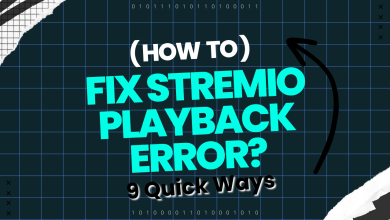Is your Chromecast Not Working on TV? Try these fixes
Chromecast is a prominent option for streaming content to the TV. However, issues with viewing content through Chromecast have been reported, causing frustration. These problems span across numerous TV manufacturers such as TCL, Vizio, Samsung, Sony, and Android TV, among others, and occur with various Chromecast dongles.
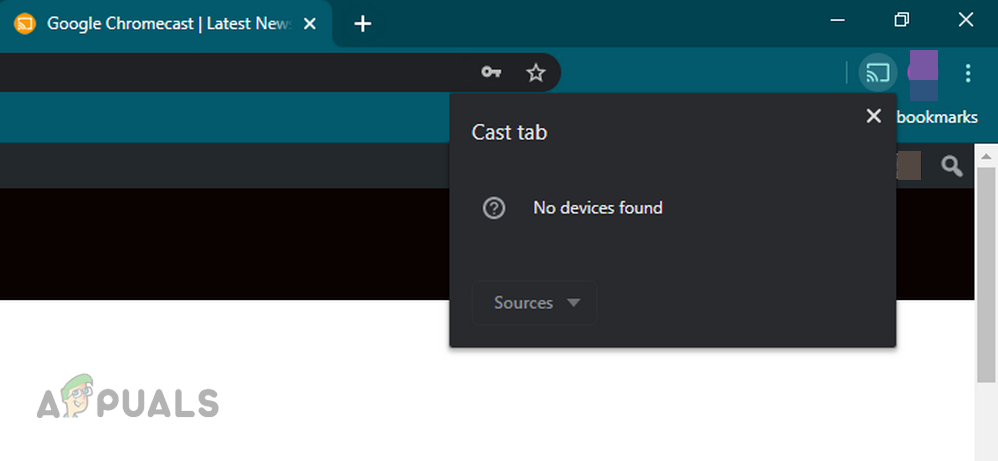
Prerequisites for Troubleshooting
- Activate and deactivate airplane mode on the streaming device.
- Turn off the Chromecast, router, and TV. Unplug their power cables, wait for a minute, then reconnect the cables and turn the devices back on.
- Update the firmware for the TV, device, router, and Chromecast.
1. Uninstall Chromecast App updates on the TV
If the recent Chromecast app update does not apply correctly to the previous installation on the TV, the app will not function. In this case, uninstalling the app’s updates should resolve the issue.
- Launch the TV Settings and go to Applications > Chromecast.
- Expand its menu and click on Uninstall Updates. Check if the Chromecast is working properly.
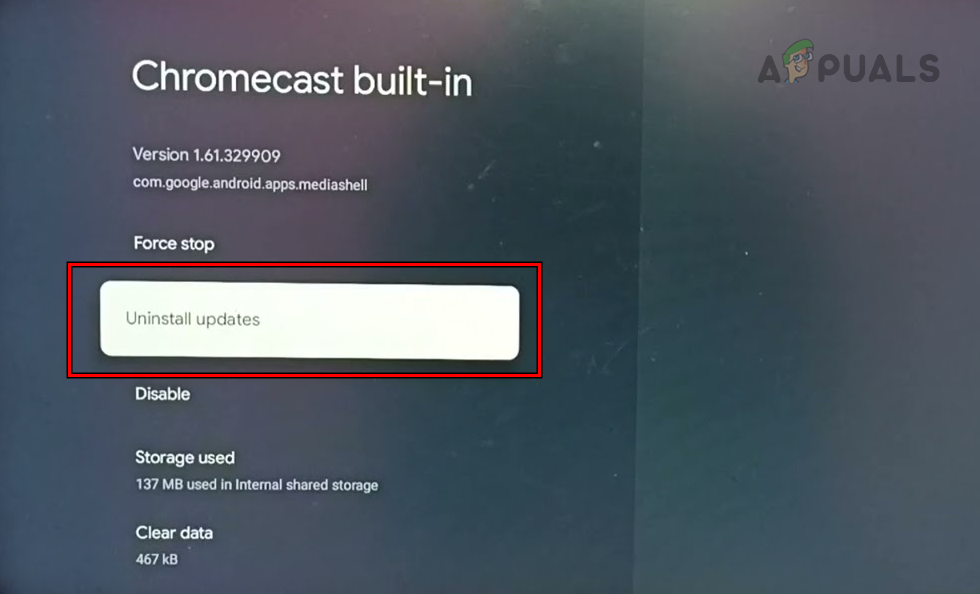
Uninstall Updates of the Chromecast App on the TV
2. Try Another Network or Hotspot from a Device
If native incompatibility exists between your network (corporate or university) and Chromecast (built-in or external), it can cause casting issues on the TV. To diagnose this problem, temporarily try a different network.
If you’re using a hotspot, it’s advisable to utilize a separate device for this purpose, so one serves as a hotspot while the other acts as a host.
- If your casting device has a VPN enabled, try disabling it to resolve the issue.
- If necessary, disconnect the devices (phone, TV, and Chromecast) from the current network and connect them to another, such as a hotspot from a different device. Alternatively, connect to the Chromecast’s Wi-Fi network.
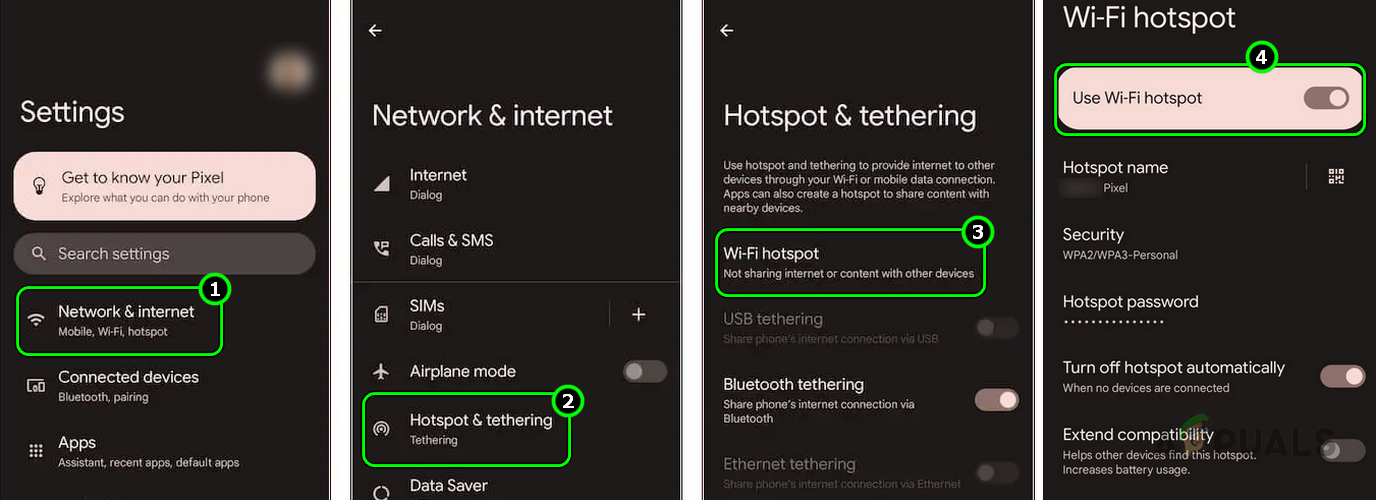
Enable Hotspot on the Android Phone - Ensure the Chromecast is accessible. If it is, configure it according to your needs.
- Disconnect the devices from the alternate network, reconnect to your regular network, and verify that the Chromecast functions properly on the TV.
3. Solutions for iPhone Casting Issues
If you’re using an iOS device, consider these solutions:
Enable Local Network Access for the App
iPhone restricts apps’ access to the local network until manually enabled. If the app on your iPhone can’t communicate with the TV on the local network, you may encounter Chromecast issues. To solve this problem, enable Local Network Access for the app in question.
- Navigate to Settings > Privacy > Local Network.
- Enable Local Network Access for the problematic app (such as Google Home, YouTube, Spotify, etc.).
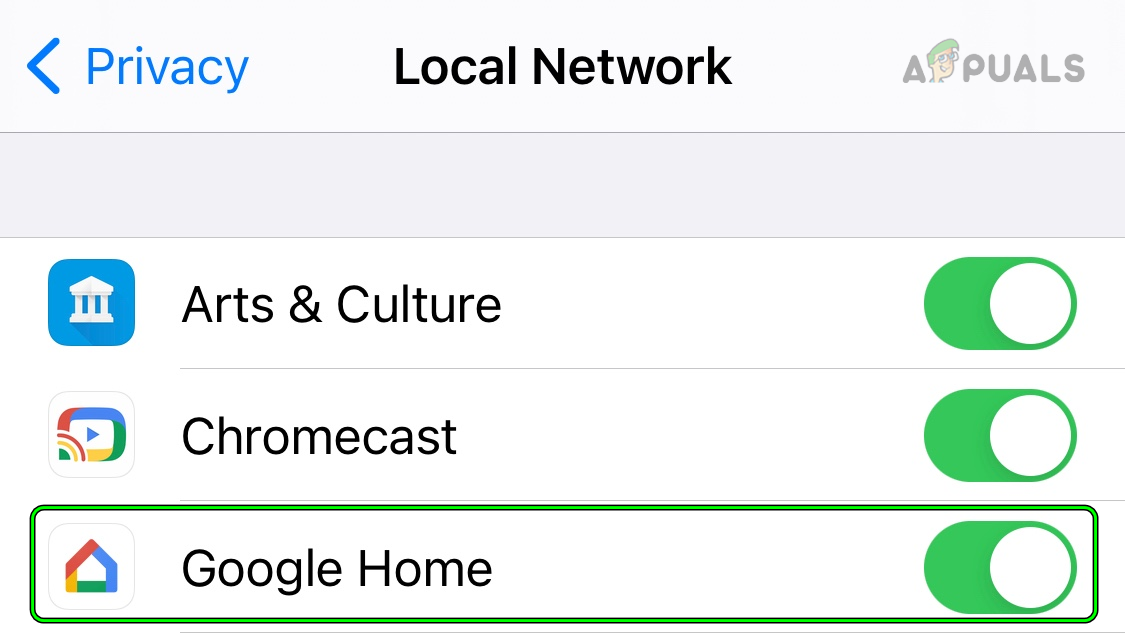
Enable Local Network for Google Home in the iPhone’s Privacy Settings - Check if the Chromecast is shown in that app.
Disable Private Address on the Phone
Your iPhone uses a software-based MAC address to shield its actual MAC address, preventing potential Wi-Fi tracking. However, this feature, designed for public networks, can cause compatibility issues with Chromecast or TVs on your home network.
You can fix this by disabling the private Mac address on the phone.
- Head to Settings > Wi-Fi > problematic network > Info icon (i).
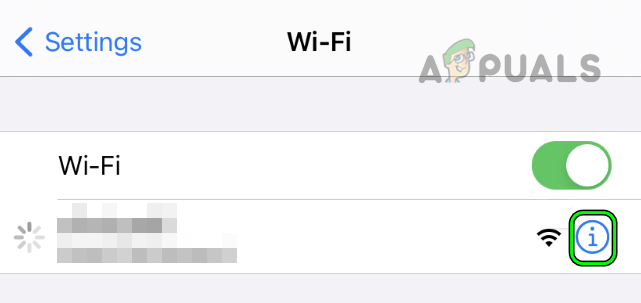
Tap on the Info Icon for Your Wi-Fi Network in the iPhone Settings - Disable Private Address and tap on Rejoin.

Disable the Private Address for the Wi-Fi Network and Rejoin the Network on the iPhone - Restart the devices (iPhone, Chromecast, TV, and router) and check if the problematic app can access Chromecast.
4. Fixes for Browser-Based Casting Devices
Enable ‘Cast Devices on All IP Addresses’ (Only on Chrome)
If your router doesn’t comply with the IP schemes outlined in RFC1918/RFC4193, Chrome cannot communicate with the TV via Chromecast. However, enabling the “Cast Devices on All IP Addresses” in Chrome’s Flags settings resolves this issue.
- Launch the Chrome browser and in the address bar, type the following:
chrome://flags/#media-router-cast-allow-all-ips
- Set the dropdown of Connect to Cast Devices on All IP Addresses to Enabled and then restart the devices.
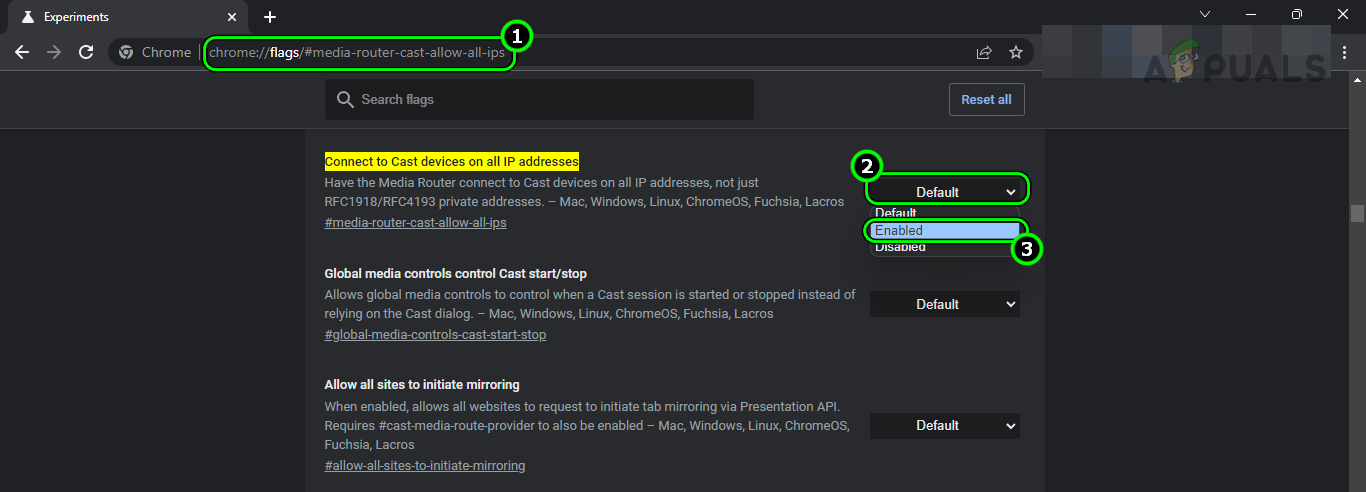
Set the Connect to Cast Devices on All IP Addresses Chrome Flag to Enabled - Upon restart, check if the Chromecast is working on the TV.
Reset the Browser’s Experimental Features to the Defaults
Most browsers have experimental features which, due to their testing nature, could disrupt streaming content from the browser to the TV via Chromecast. Resetting these features to default may resolve the issue.
To reset Chrome’s Flags to their defaults:
- Launch the Chrome browser and enter the following in the address bar:
chrome://flags/
- Click on Reset All and then confirm to reset all Chrome’s flags to their default state.
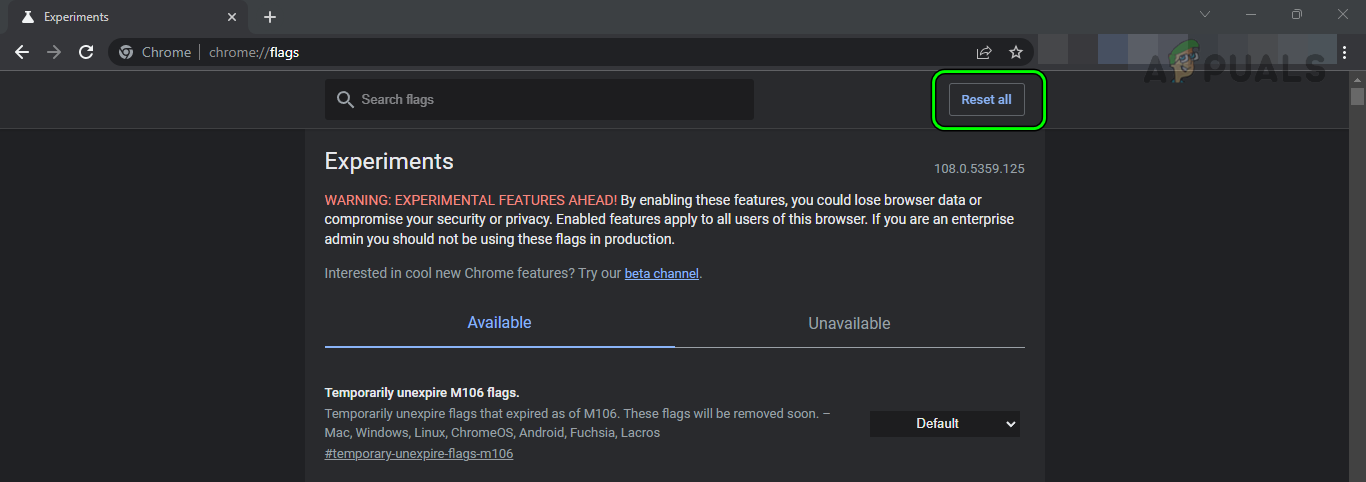
Reset All the Chrome Flags to the Defaults - Relaunch Chrome and check if it can access Chromecast.
5. Fix for Android as a Casting Device
If the app’s data becomes invalid, the casting app cannot communicate with the TV on the local network. Furthermore, Google Play Services manages many background operations, including network communications, on Android. If this app’s data becomes damaged, it could also lead to issues.
To solve this issue, clear the storage for the problematic app and Google Play Services.
- Navigate to Settings > Application Manager > problematic app (such as Google Home or Spotify).
- Force Stop the app and open Storage.
- Clear the Cache and Data.
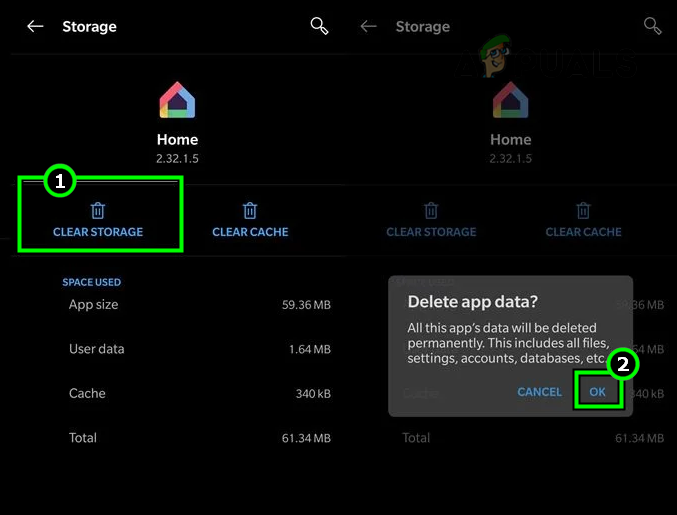
Clear Storage of the Google Home App - Repeat the same for the Google Play Services. Enable viewing of the system apps if Google Play Services is not shown in the Application Manager.
- Restart your phone and check if the Chromecast is operating correctly on the TV.
6. Fix for Windows as a Casting Device
Windows PCs handle private and public network connections differently. To communicate with devices, like TVs, on the local network, the network connection type on the PC needs to be set to private.
If your PC’s connection type is set to public, it blocks local network communications, making the TV inaccessible via Chromecast. To fix this, switch the PC’s network connection type to private.
- Right-click on the network icon in the system’s tray.
- Navigate to Network and Internet Settings > Properties.
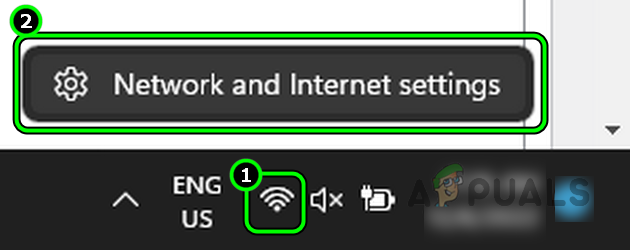
Open Network and Internet Settings of the Windows PC - Select Private and hit the back button.

Open Properties of the Network on a Windows PC - Check if the Chromecast is working on the TV.
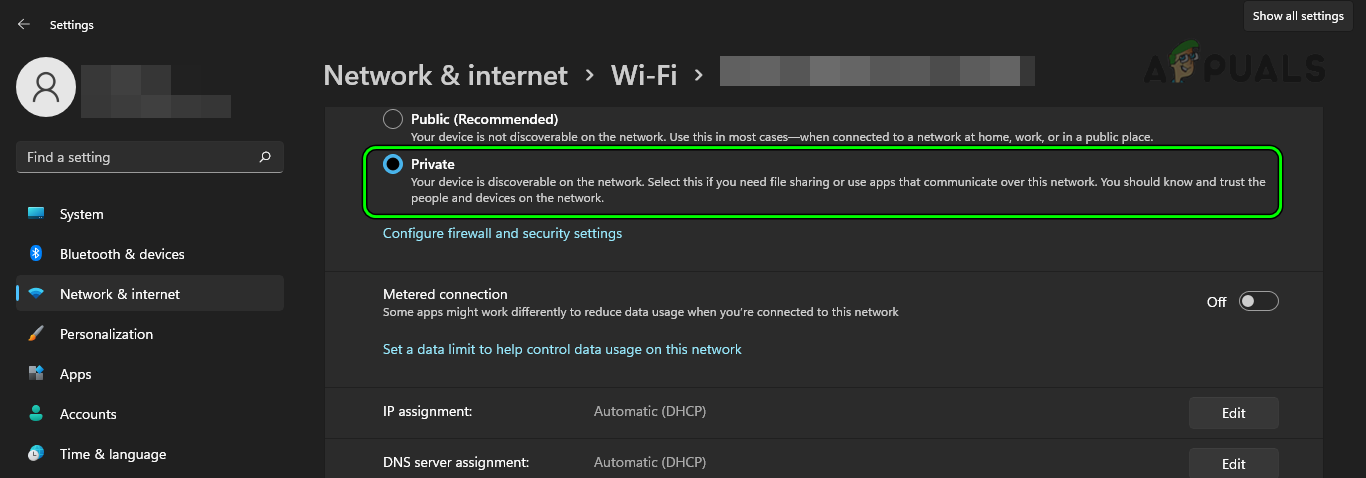
Change the Network Type to Private on a Windows PC
7. Reinstall the Problematic App
If the latest update has disrupted the core modules of the active app, you won’t be able to use Chromecast on your TV. To remedy this, reinstall the troublesome app on your phone.
To reinstall the Google Home app on an Android phone:
- Navigate to Settings > Application Manager > Google Home.
- Force Close the app and open Storage.
- Clear the Cache and Data.
- Hit the back button and Uninstall.
- Uninstall the Google Play Services or uninstall its updates (if the Services app cannot be uninstalled).
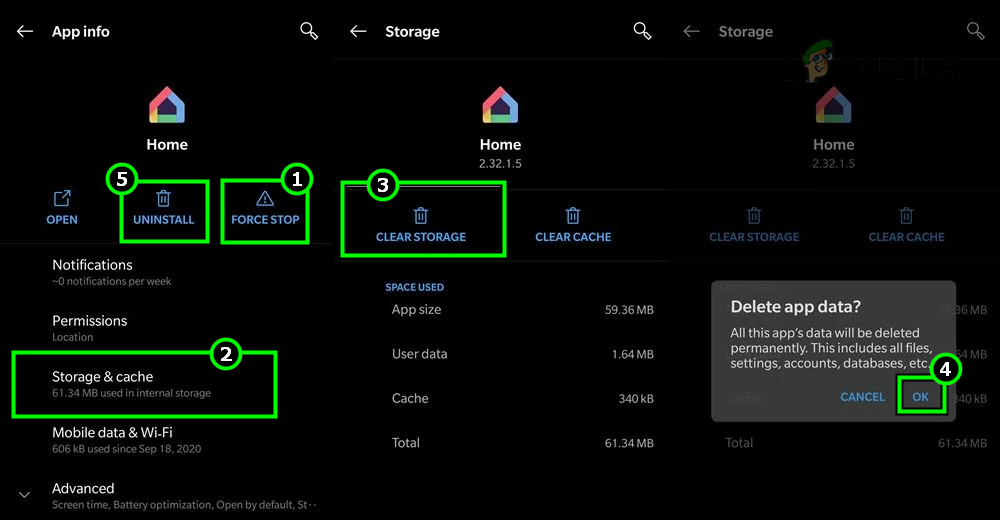
Uninstall the Google Home App on the Android Phone - Restart your phone and reinstall the Google Play Services app or update it.
- Reinstall the Google Home app and check if it is communicating with the Chromecast.
8. Edit Router Configurations
Many router configurations can prevent Chromecast from working with your TV. Modifying these configurations as discussed below should solve the issue.
For each setting, log into the management portal of your router in a web browser or app.
Disable AP Isolation in the Router’s Settings
In some routers, this setting may be called Privacy Separator or Communication between Wi-Fi Devices, and you will need to disable these settings. To disable AP Isolation on a TP-Link router:
- Navigate to Settings > Advanced > Wireless > Advanced Settings.
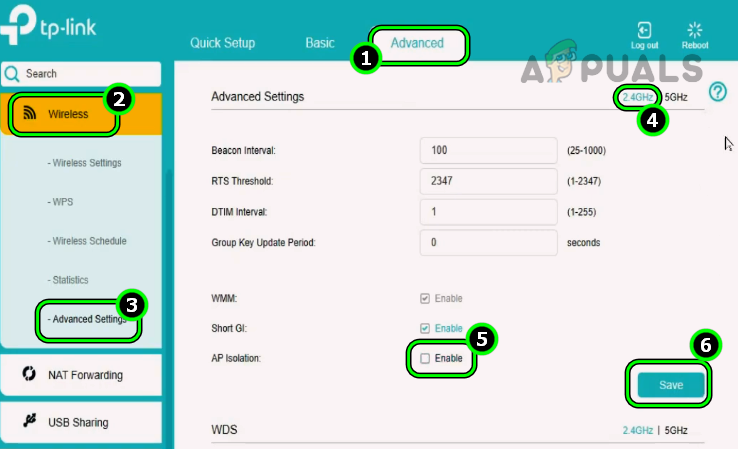
Disable AP Isolation on a TP-Link Router - Deselect Enable for AP Isolation. For a dual-band router, select the wireless band first like 2.4GHz, and disable AP Isolation for both bands.
- Save the changes and restart your devices.
- Launch the problematic app and check if it can communicate with the Chromecast TV.
Disable the Smart or Auto Connect Feature of the Router
- Navigate to Settings > Advanced > Wireless > Wireless Settings.
- Disable the Smart Connect feature and save changes.
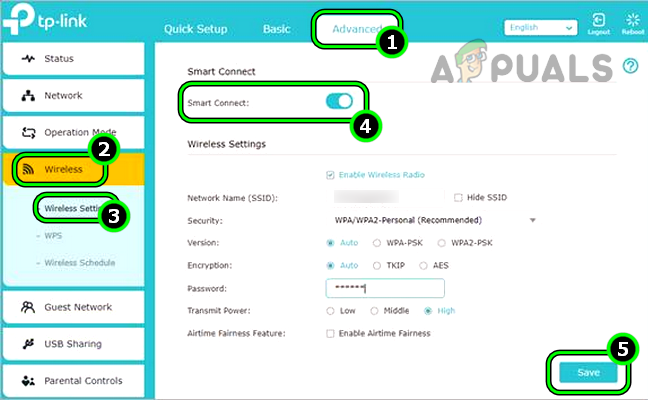
Disable Smart Connect on a TP-Link Router - Restart the devices and check if the problematic app can see the Chromecast TV.
Disable Internet Group Management Protocol
- Navigate to Settings > Advanced > Routing.
- Set Internet Group Management Protocol (IGMP) to disable and save the changes.
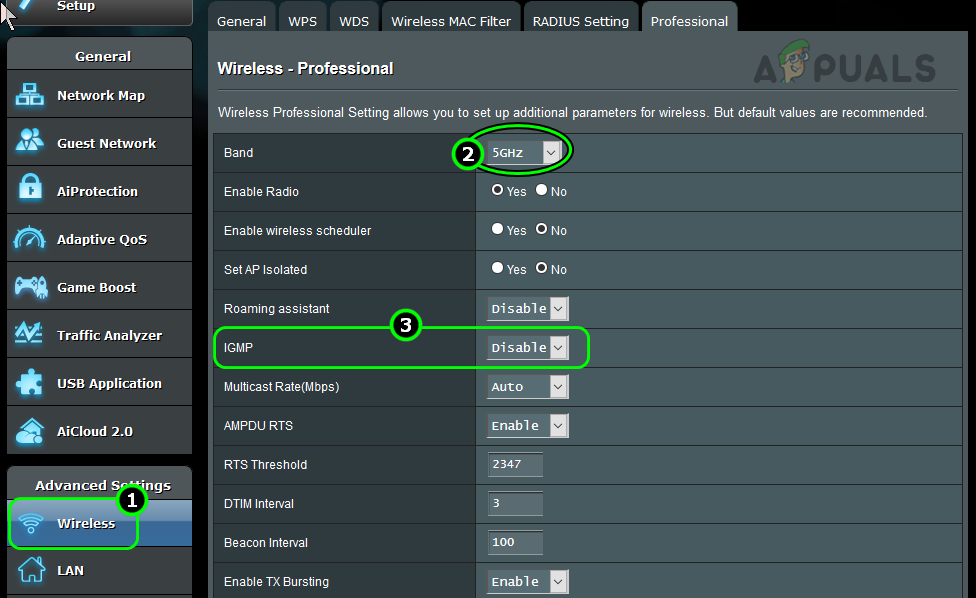
Disable IGMP in the Router Settings - Restart the devices (router, Chromecast, TV, and phone) and check if Chromecast is accessible on the network.
- If that does not work, enable Multicast and restart the devices. See if that solves the problem.
Disable Airtime Fairness in the Router Settings
- Navigate to Settings > Wireless > Professional.
- Select the 2.4GHz band and disable Airtime Fairness.
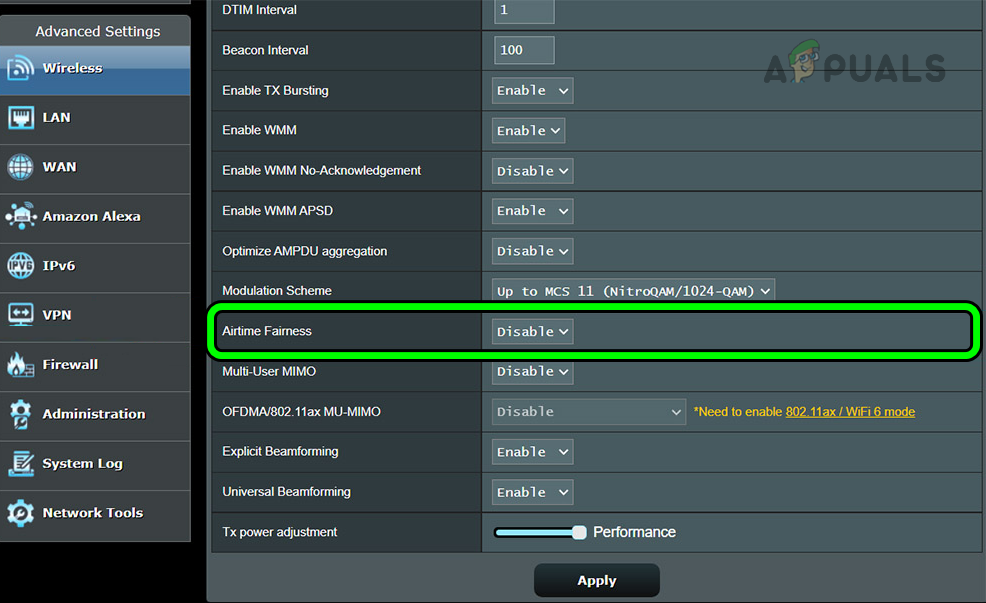
Disable Airtime Fairness in the Router Settings - Repeat the same for the 5GHz band and restart the router, phone, TV, and Chromecast.
- Launch the problematic app and check if the Chromecast is available to stream content.
Disable Router’s MU-MIMO
To turn off MU-MIMO on an Asus router:
- Navigate to Settings > Wireless.
- Set MU-MIMO to disable. In the case of a dual-band router, repeat the same for both bands.
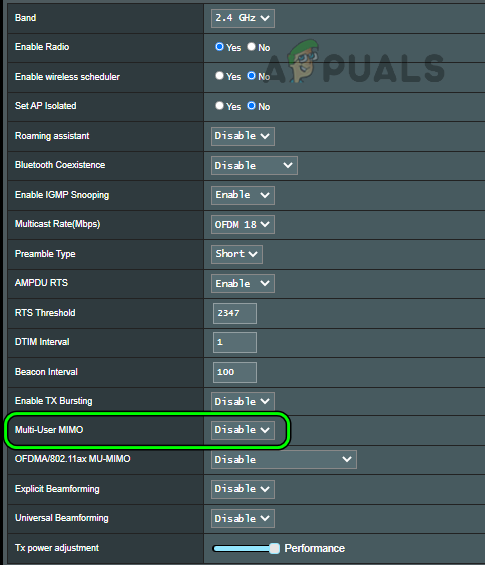
Disable MU-MIMO in the Router Settings - Save the changes and restart the devices.
- Upon restart, check if the Chromecast is accessible in the problematic app.
Disable WMM in the Router’s Settings
To disable WMM on a Netgear router:
- Navigate to Settings > Advanced > Setup > QoS.
- Set the Enable WMM option to disable. For a dual-band router, make sure to disable WMM for both bands.
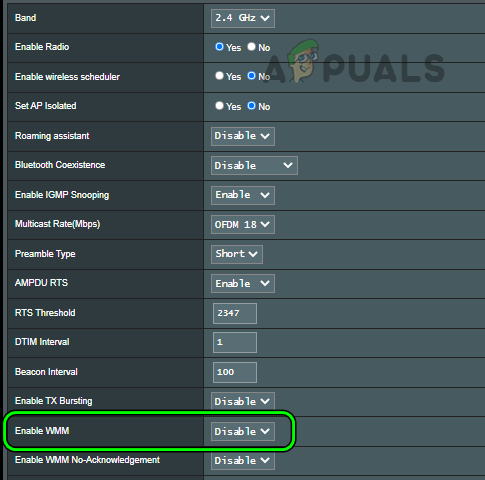
Disable WMM in the Router Settings - Save the changes made and restart the devices.
- Upon restart, launch the problematic app and check if Chromecast is shown there.
Disable Beamforming in the Router Settings
Here’s how to turn off beamforming on a Netgear router.
- Navigate to Settings > Advanced > Advanced Setup > Wireless Settings.
- Disable Explicit Beamforming and Implicit Beamforming.
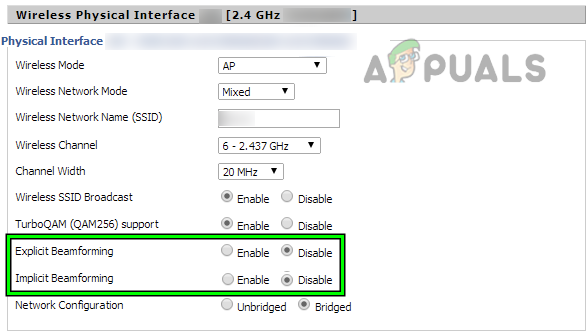
Disable Beamforming on an Asus Router - Apply the changes and restart the devices (router, TV, Chromecast, phone, etc.,).
- Once restarted, check if Chromecast is working on the TV.
Disable the Guest Network of the Router
To disable Guest Wi-Fi on a TP-Link dual-band router:
- Navigate to the Guest Network tab and uncheck Guest Network (2.4GHz).
- Untick Guest Network (5GHz) and apply the changes.
- Restart the devices and check if the Chromecast issue is resolved on the TV.
Enable UPnP in the Router Settings
To do so on a TP-Link router:
- Go to Settings > Advanced > NAT Forwarding > UPnP.
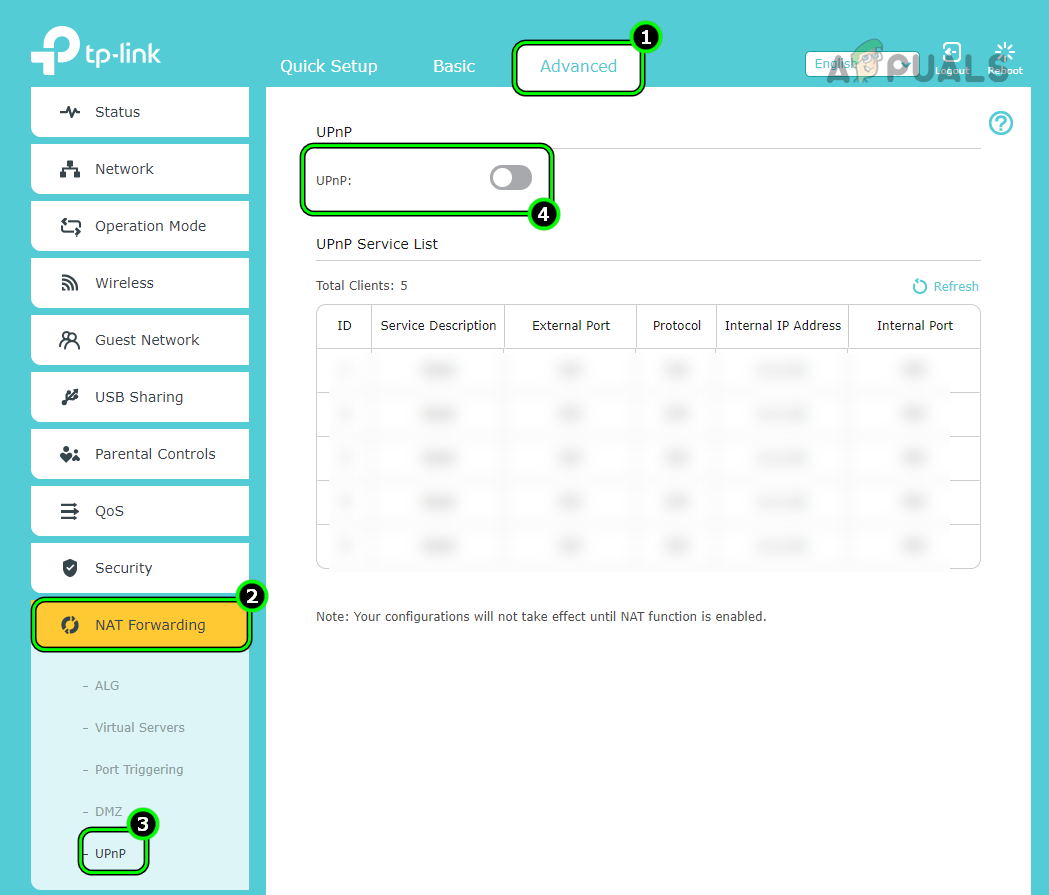
Enable UPnP in the Router’s Settings - Enable UPnP and save the changes.
- Restart the devices and launch the problematic app. Check if the Chromecast problem is solved.
Enable the 2.4GHz Band and Disable 5GHz Band on the Router
To do this on a Virgin Media router:
- Go to Settings > Advanced Settings > Wireless Signal.
- Tick the checkbox for Enable 2.4GHZ band.
- Check the checkbox for Disable 5GHz.
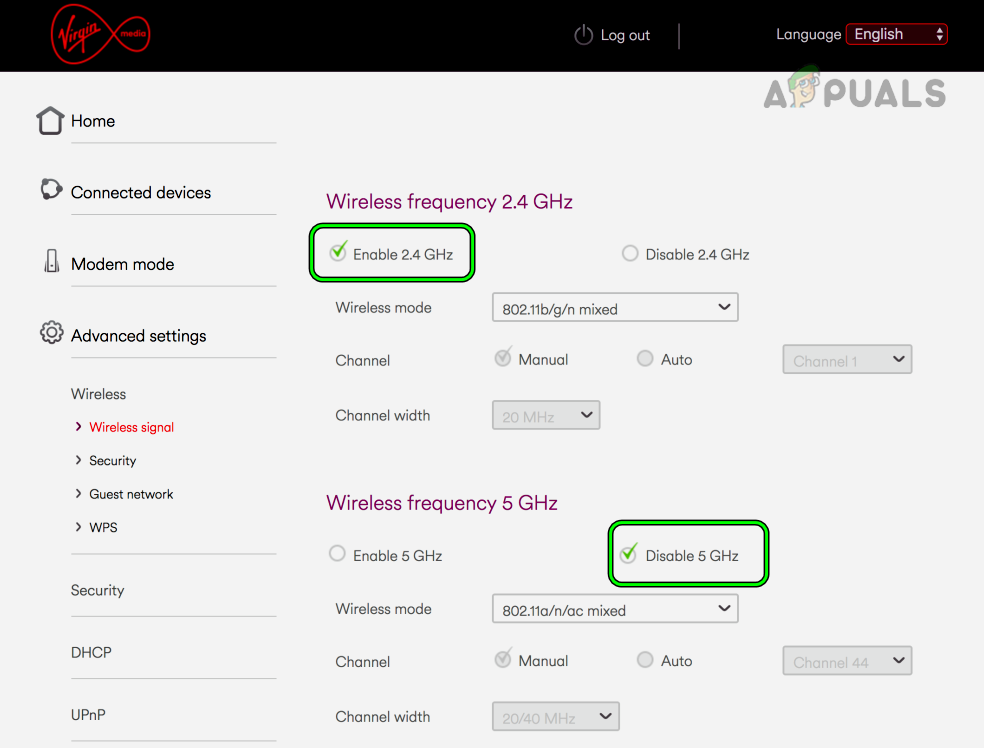
Enable 2.4GHz Band on the Router and Disable 5GHz Band - Save the changes and connect the Chromecast, TV, and phone to the router’s 2.4GHz band.
- Open the problematic app and check if the Chromecast issue is resolved.
- If not, check if changing the channel of the router solves the problem. You can use a Wi-Fi analyzer app to search for the best Wi-Fi channel for your network.
If the problem was cleared with 2.4GHz but you need to use 5GHz for other devices that may require a faster Internet connection, split the SSIDs of both bands, and enable the 5GHz band.
Disable the IPv6 Feature of the Router
To disable IPv6 for a TP-Link router;
- Navigate to IP Support > IPv6 Setup.
- Untick the option of Enable IPv6 and save the changes.
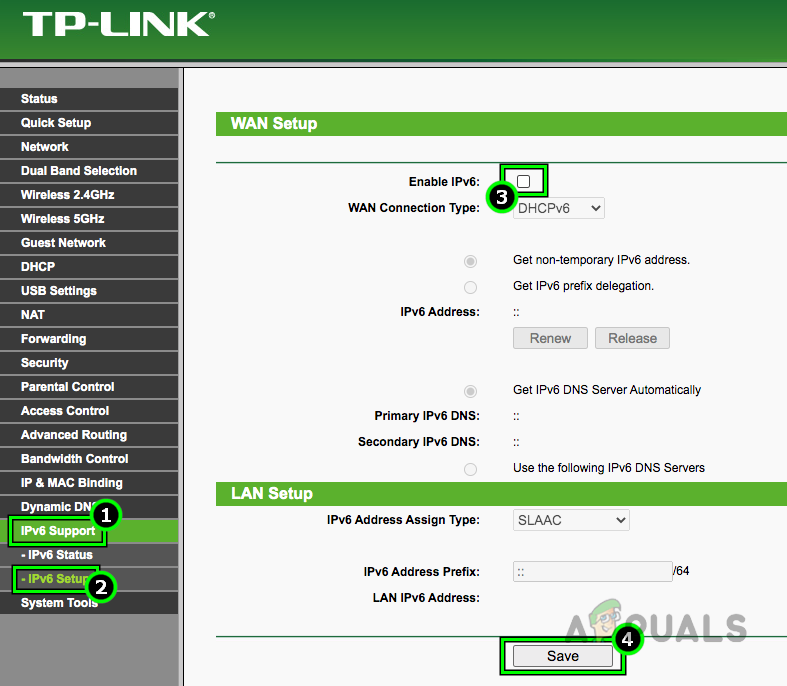
Disable IPv6 in the Router’s Settings - Restart your devices and check if the Chromecast is operating properly on the TV.
Disable Guest Mode on the Chromecast
You may need to either connect the devices to the Chromecast Wi-Fi or use another network like the phone’s hotspot to disable Guest Mode on the device.
- Launch the Google Home app.
- Navigate to the problematic Chromecast > Settings > Guest Mode.
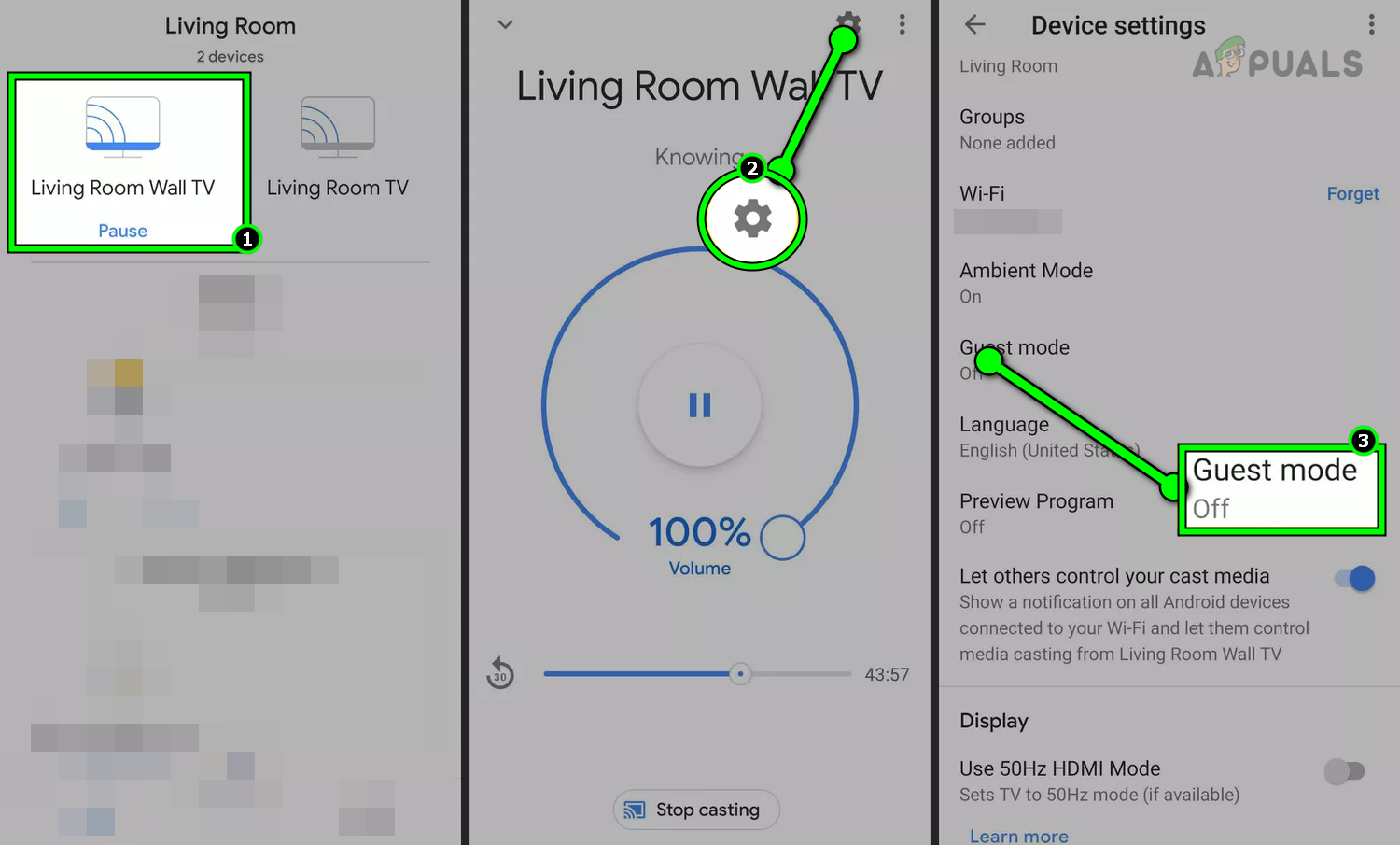
Disable Guest Mode in the Chromecast Settings - Disable Guest Mode and connect the devices to your regular network.
- Launch the problematic app (such as Spotify) and log out of it.
- Restart the phone and log into the problematic app. Check if the Chromecast problem is solved.
- If the guest mode was already off, check if enabling it clears the issue.
Enable the Zero Configuration of the Router
To enable Zero Configuration on an Xfinity router:
- Navigate to Settings > Advanced > Device Discovery.
- Enable Zero Config and save the changes.
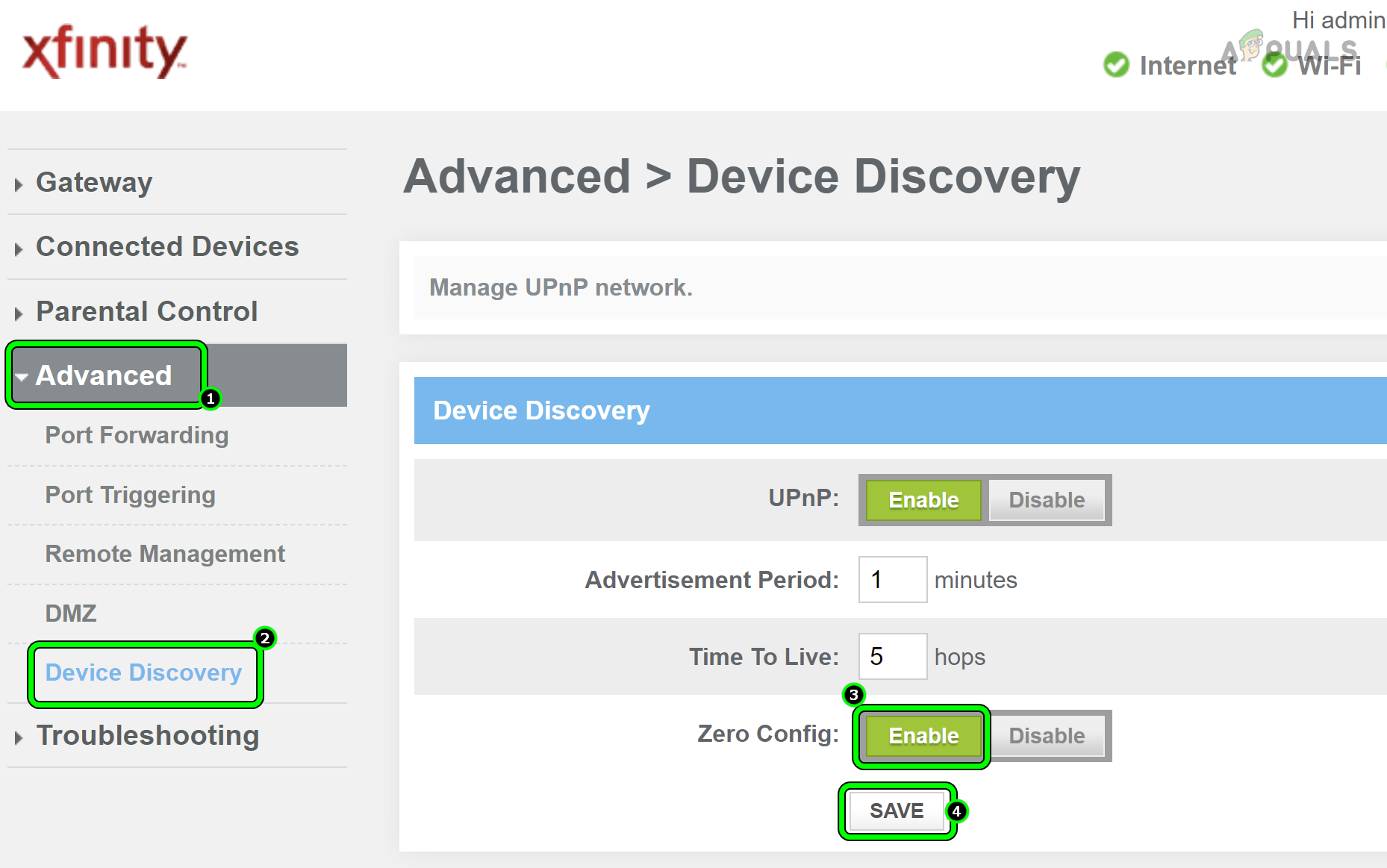
Enable Zero Config for an Xfinity Router - Restart the devices (phone, Chromecast, TV, and router) and check if the Chromecast is functioning correctly on the TV.
If the issue persists, reset Chromecast, TV, and router to factory defaults. Verify if the problem is solved. If this does not work, reset the casting device to its default settings. If this fails in rectifying the problem, contact Google support for assistance.
 Reviewed by
Reviewed by 




